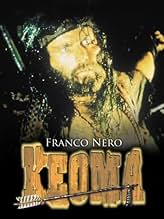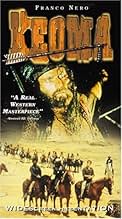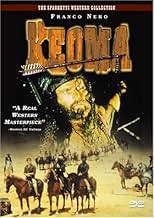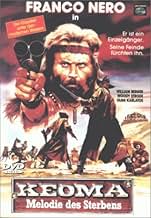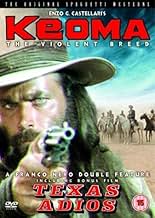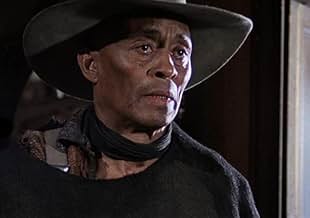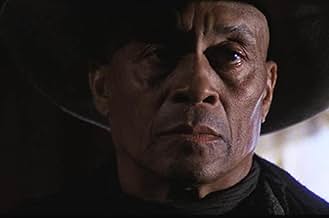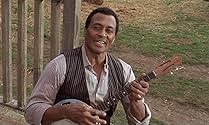IMDb-BEWERTUNG
7,0/10
6556
IHRE BEWERTUNG
Ein ehemaliger Revolverheld versucht, seine von der Pest heimgesuchte Heimatstadt vor der Übermacht seiner rassistischen Halbbrüder und eines konföderierten Tyrannen zu schützen.Ein ehemaliger Revolverheld versucht, seine von der Pest heimgesuchte Heimatstadt vor der Übermacht seiner rassistischen Halbbrüder und eines konföderierten Tyrannen zu schützen.Ein ehemaliger Revolverheld versucht, seine von der Pest heimgesuchte Heimatstadt vor der Übermacht seiner rassistischen Halbbrüder und eines konföderierten Tyrannen zu schützen.
Joshua Sinclair
- Sam Shannon
- (as John Loffredo)
Donald O'Brien
- Caldwell
- (as Donald O'Brian)
Leonardo Scavino
- Doctor
- (as Leon Lenoir)
Antonio Basile
- Caldwell's Henchman
- (Nicht genannt)
Giovanni Bonadonna
- Caldwell's Henchman
- (Nicht genannt)
Armando Bottin
- Caldwell's Henchman
- (Nicht genannt)
Aldo Canti
- Wagon Fugitive
- (Nicht genannt)
- …
Felice Ceciarelli
- Caldwell's Henchman
- (Nicht genannt)
Empfohlene Bewertungen
After the American Civil War, the half-breed Keoma (Franco Nero) returns to his homeland and rescues a beautiful pregnant woman accused of having plague, Lisa (Olga Karlatos), from a gang leaded by the landlord Caldwell (Donald O'Brian). Later he meets his former slave servant and friend George (Woody Strode), now a drunk free man, and his father, William Shannon (William Berger), and he is informed that the town is under siege of Caldwell's men, without supplies of medicine or food and justice, with the dweller dying of plague and starvation and sick people is being isolated in an old mine. Further, his three dangerous half-brothers have joined Caldwell's force. Keoma decides to help Lisa and the dwellers to retrieve their freedom and dignity, and he finds how despicable the inhabitants are.
The unknown western "Keoma" was a great surprise for me. Although predictable, the story is great, disclosing the relationship of Keoma with his brothers and father through his recollections from his childhood, and does not have a happy commercial end. Franco Nero is amazing in the role of a lonely half-Indian with a great sense of justice and freedom, love and loyalty to his father and regret and resentment to his half-brothers. The direction and cinematography are excellent, with a fantastic choreography of the fights, set decoration and costumes: in the dusty, windy and dirty city, the men's clothes (and themselves) are very dirty, and not like in most of Hollywood movies, where the cowboys wear very clean clothes. There is a particular scene that I believe is unique in the cinema, when Keoma promises four bullets for four hit men, and while bending his four fingers, we see each of his targets. The annoying soundtrack, although having the good intention of creating a narrative of the feelings of the characters, is the only negative aspect in this movie. My vote is seven.
Title (Brazil): "Keoma"
The unknown western "Keoma" was a great surprise for me. Although predictable, the story is great, disclosing the relationship of Keoma with his brothers and father through his recollections from his childhood, and does not have a happy commercial end. Franco Nero is amazing in the role of a lonely half-Indian with a great sense of justice and freedom, love and loyalty to his father and regret and resentment to his half-brothers. The direction and cinematography are excellent, with a fantastic choreography of the fights, set decoration and costumes: in the dusty, windy and dirty city, the men's clothes (and themselves) are very dirty, and not like in most of Hollywood movies, where the cowboys wear very clean clothes. There is a particular scene that I believe is unique in the cinema, when Keoma promises four bullets for four hit men, and while bending his four fingers, we see each of his targets. The annoying soundtrack, although having the good intention of creating a narrative of the feelings of the characters, is the only negative aspect in this movie. My vote is seven.
Title (Brazil): "Keoma"
Director Castellari is nowadays perhaps best-known (if at all) by the younger generation of film buffs for one thing: making the original INGLORIOUS BASTARDS (1977), which Quentin Tarantino has been threatening to remake for years now. However, in my opinion, he should instead be remembered for making this impressive, belated Spaghetti Western gem.
An odd blend of violent action and heady mysticism apparently concocted by one of the credited screenwriters Luigi Montefiori (better known to hardened Euro-Cult fans as an actor under the alias of George Eastman) but, as star Franco Nero and Castellari himself state in the Anchor Bay DVD supplements, the script took so long to get written that they decided to work without one and make the dialogue up as they went along! That the end result is so satisfying (and practically unique in the subgenre) is a remarkable achievement in itself.
Keoma is a half-breed returning home from the American Civil War to find his hometown ravaged by the plague and overtaken by the villainous Caldwell (Donal O' Brien); among his cohorts are Nero's three half-brothers who had made his childhood a living hell, with his surrogate father (William Berger) and colored mentor turned banjo-playing town-drunk (Woody Strode) unable to do much to counter Caldwell's oppression. A Bergmanesque, cadaverous old woman is frequently seen roaming the streets dragging a cart behind her...
What follows is the typical confrontation between Good and Evil but Castellari infuses the familiar mixture with several directorial flourishes: occasionally striking compositions (particularly a memorably Fordian opening shot), frequent use of slow-motion in true Peckinpah-style, flashbacks in which Keoma is a spectator to his own past experiences (inspired by Elia Kazan's THE ARRANGEMENT [1969]!), a touch of elliptical editing, Christian symbolism (Keoma is crucified at one point) and, most distressingly of all, a folksy soundtrack (inspired by Leonard Cohen and Bob Dylan, no less and warbled...er...sung by a shrill, high-pitched female singer and an out-of-tune deep-voiced male) which narrates in song the action we're seeing on the screen. I say distressingly because the Guido and Maurizo De Angelis compositions found here have forever been a thorn in the side of even the film's staunchest admirers!! Personally, I didn't mind the female singer so much after a while but when her (possibly drunk) male companion took over in the last half hour, I was in for some cringe-inducing moments for sure...!
Despite these misgivings, the film is still one of the best Spaghetti Westerns out there (and certainly the last great example of the subgenre); its undoubted highlight is provided by a terrific, lovingly protracted action set-piece in which Nero, Berger and a reformed Strode (back to his former arrow-shooting glory - perhaps a nod to the role he played in Richard Brooks' splendid THE PROFESSIONALS [1966]) wipe out most of Caldwell's gang. Their triumph is short-lived, however, because both Berger and Strode lose their lives in the ongoing struggle (Berger poignantly so, while Strode's death scene is particularly great), with Nero almost bowing out himself under the strain of his siblings' torture - who have subsequently disposed of Caldwell and taken over the town themselves; the final confrontation, then, between Keoma and his three half-brothers is eerily set to the "strains" of Olga Karlatos' (playing a woman Keoma had earlier on saved from a plague-infested colony) wailing and screaming as she lies giving birth to a child amidst the carnage!
While at first I was disappointed that the Anchor Bay DVD only included the English dub, having watched it now it seems clear that the actors were all speaking their dialogue in English on the set - although, as connoisseurs will certainly know, this was all re-recorded back in the studios anyway (as was common practice in the Italian film industry). Still, if ever it gets shown again on Italian TV, I'll be sure to check it out just for completeness' sake. Thankfully, however, Castellari contributes a highly enthusiastic and informative Audio Commentary in which he discusses his major influences while making the film, among them Sidney J. Furie's THE APPALOOSA (1966), Altman's McCABE AND MRS. MILLER (1971) and Peckinpah's PAT GARRETT AND BILLY THE KID (1973).
Ultimately, Franco Nero in the title role is almost as iconic a figure as Django and, hopefully, I should be getting to another fairly obscure but highly intriguing Spaghetti Westen of his - Luigi Bazzoni's MAN, PRIDE AND VENGEANCE (1968), an eccentric updating of Georges Bizet's opera "Carmen", co-starring Klaus Kinski and Tina Aumont - pretty soon...
An odd blend of violent action and heady mysticism apparently concocted by one of the credited screenwriters Luigi Montefiori (better known to hardened Euro-Cult fans as an actor under the alias of George Eastman) but, as star Franco Nero and Castellari himself state in the Anchor Bay DVD supplements, the script took so long to get written that they decided to work without one and make the dialogue up as they went along! That the end result is so satisfying (and practically unique in the subgenre) is a remarkable achievement in itself.
Keoma is a half-breed returning home from the American Civil War to find his hometown ravaged by the plague and overtaken by the villainous Caldwell (Donal O' Brien); among his cohorts are Nero's three half-brothers who had made his childhood a living hell, with his surrogate father (William Berger) and colored mentor turned banjo-playing town-drunk (Woody Strode) unable to do much to counter Caldwell's oppression. A Bergmanesque, cadaverous old woman is frequently seen roaming the streets dragging a cart behind her...
What follows is the typical confrontation between Good and Evil but Castellari infuses the familiar mixture with several directorial flourishes: occasionally striking compositions (particularly a memorably Fordian opening shot), frequent use of slow-motion in true Peckinpah-style, flashbacks in which Keoma is a spectator to his own past experiences (inspired by Elia Kazan's THE ARRANGEMENT [1969]!), a touch of elliptical editing, Christian symbolism (Keoma is crucified at one point) and, most distressingly of all, a folksy soundtrack (inspired by Leonard Cohen and Bob Dylan, no less and warbled...er...sung by a shrill, high-pitched female singer and an out-of-tune deep-voiced male) which narrates in song the action we're seeing on the screen. I say distressingly because the Guido and Maurizo De Angelis compositions found here have forever been a thorn in the side of even the film's staunchest admirers!! Personally, I didn't mind the female singer so much after a while but when her (possibly drunk) male companion took over in the last half hour, I was in for some cringe-inducing moments for sure...!
Despite these misgivings, the film is still one of the best Spaghetti Westerns out there (and certainly the last great example of the subgenre); its undoubted highlight is provided by a terrific, lovingly protracted action set-piece in which Nero, Berger and a reformed Strode (back to his former arrow-shooting glory - perhaps a nod to the role he played in Richard Brooks' splendid THE PROFESSIONALS [1966]) wipe out most of Caldwell's gang. Their triumph is short-lived, however, because both Berger and Strode lose their lives in the ongoing struggle (Berger poignantly so, while Strode's death scene is particularly great), with Nero almost bowing out himself under the strain of his siblings' torture - who have subsequently disposed of Caldwell and taken over the town themselves; the final confrontation, then, between Keoma and his three half-brothers is eerily set to the "strains" of Olga Karlatos' (playing a woman Keoma had earlier on saved from a plague-infested colony) wailing and screaming as she lies giving birth to a child amidst the carnage!
While at first I was disappointed that the Anchor Bay DVD only included the English dub, having watched it now it seems clear that the actors were all speaking their dialogue in English on the set - although, as connoisseurs will certainly know, this was all re-recorded back in the studios anyway (as was common practice in the Italian film industry). Still, if ever it gets shown again on Italian TV, I'll be sure to check it out just for completeness' sake. Thankfully, however, Castellari contributes a highly enthusiastic and informative Audio Commentary in which he discusses his major influences while making the film, among them Sidney J. Furie's THE APPALOOSA (1966), Altman's McCABE AND MRS. MILLER (1971) and Peckinpah's PAT GARRETT AND BILLY THE KID (1973).
Ultimately, Franco Nero in the title role is almost as iconic a figure as Django and, hopefully, I should be getting to another fairly obscure but highly intriguing Spaghetti Westen of his - Luigi Bazzoni's MAN, PRIDE AND VENGEANCE (1968), an eccentric updating of Georges Bizet's opera "Carmen", co-starring Klaus Kinski and Tina Aumont - pretty soon...
A mestizo ex-soldier named Keoma (Franco Nero's long hair is a wig) helps a pregnant woman (Olga Karlatos) from cutthroats. Keoma (the word/name Keoma means freedom) returns to a small town after the Civil War . The ghastly village is ruled by violent outlaw gangs (led by Donald O'Brien), along with Keoma's three brother . Half-breed Keoma is helped by an alcoholic old man (Woody Strode) and his adoptive father (William Berger). The bandits leader prohibits the inhabitants leave from damned little town besieged by pest .
This twilight spaghetti Western packs a decrepit aesthetic, racist denounce and innovating scenarios set in Elios studios by designer production Carlo Simi, Sergio Leone's regular. There is full of action in the movie, guaranteeing fist-play, stunts and shootouts every few minutes and in Sam Peckinpah style. Franco Nero is cool, he bears a remarkable physical resemblance to JesusChrist , he helps a hapless pregnant and is crucified in Christian symbolic sequence. Interesting and thought-provoking screenplay by Luigi Montefiori or George Eastman who starred numerous Westerns. The plot of the film was mostly improvised at the same time the film was made, but director Enzo G. Castellari didn't appeal the original story. Because of problems with Schedule, the script was written for next day every evening, after filming at the day. Usual Spaghetti western secondaries appear, such as: William Berger, Ken Wood, Robert Dell'Acqua and Ricardo Pizzuti of the Terence Hil and Spencer films. Sensitive, perceptible musical score by Guido and Maurizio De Angelis with emotive atmosphere nearly the songs performed by Bob Dylan and Leonard Cohen. The picture was well produced by Manolo Bolognini, usual producer of Italian Westerns, such as: ¨Django¨, ¨Goodbye Texas¨ , ¨Boot Hill¨ , ¨Gunman of Ave Maria¨ and ¨California¨. Director Enzo G. Castellari has stated that out of all the films he has directed, Keoma this is his personal favorite . Followed by a sequel titled 'Jonathan of the bears' (1994) again with Franco Nero and director Enzo G. Castellari, being shot in Russia and including notable reminiscences with 'Dances with wolves', but the film failed at box office . Keoma was the 'swang song 'of Spaghetti because made not much after and resulted to be the 'coup of grace' of Italian Western.
This twilight spaghetti Western packs a decrepit aesthetic, racist denounce and innovating scenarios set in Elios studios by designer production Carlo Simi, Sergio Leone's regular. There is full of action in the movie, guaranteeing fist-play, stunts and shootouts every few minutes and in Sam Peckinpah style. Franco Nero is cool, he bears a remarkable physical resemblance to JesusChrist , he helps a hapless pregnant and is crucified in Christian symbolic sequence. Interesting and thought-provoking screenplay by Luigi Montefiori or George Eastman who starred numerous Westerns. The plot of the film was mostly improvised at the same time the film was made, but director Enzo G. Castellari didn't appeal the original story. Because of problems with Schedule, the script was written for next day every evening, after filming at the day. Usual Spaghetti western secondaries appear, such as: William Berger, Ken Wood, Robert Dell'Acqua and Ricardo Pizzuti of the Terence Hil and Spencer films. Sensitive, perceptible musical score by Guido and Maurizio De Angelis with emotive atmosphere nearly the songs performed by Bob Dylan and Leonard Cohen. The picture was well produced by Manolo Bolognini, usual producer of Italian Westerns, such as: ¨Django¨, ¨Goodbye Texas¨ , ¨Boot Hill¨ , ¨Gunman of Ave Maria¨ and ¨California¨. Director Enzo G. Castellari has stated that out of all the films he has directed, Keoma this is his personal favorite . Followed by a sequel titled 'Jonathan of the bears' (1994) again with Franco Nero and director Enzo G. Castellari, being shot in Russia and including notable reminiscences with 'Dances with wolves', but the film failed at box office . Keoma was the 'swang song 'of Spaghetti because made not much after and resulted to be the 'coup of grace' of Italian Western.
Though to be clear I wouldn't go as far as to call it "the best". Something the people involved are quick to point out or to. This is really good and you have a very charismatic (and hairy chested) Franco Nero starring. You also have supernatural elements, that may not be fully explained (not even by all the extras on the disc).
And you have old school shooutous, where bad guys seem to only need one bullet to bite the dust (literally), whereas good people have to be shot quite a few times mostly. So yes there are things that may seem or feel dated, but the overall sense is quite great. Not to mention the performances. Really telling and really inspired overall.
And you have old school shooutous, where bad guys seem to only need one bullet to bite the dust (literally), whereas good people have to be shot quite a few times mostly. So yes there are things that may seem or feel dated, but the overall sense is quite great. Not to mention the performances. Really telling and really inspired overall.
Castellari's Keoma was part of the late 1970's second wave of spaghetti westerns. It is typically considered one of the better entries in the genre, some even rate it as a classic alongside Leone's masterpieces. However, while it has clearly been attempted to make the film look stylish and sophisticated, and at a casual glance it does look pretty well made, a more in depth look shows that it falls quite a long way off the mark.
Basically, it's clear that what Castellari has is a bunch of director's tricks up his sleeve - slow motion, unconventional camera angles, subtle merges into flashbacks and so on - all of them thieved from the work of other filmmakers. That in itself is no bad thing - after all Tarantino has made a career out of doing the same - but the difference is that Castellari clearly has no idea how and when to use these techniques. He simply throws them in at every opportunity, so that they actually stick out rather than enhance the film. The most obvious example is the Sam Peckinpah style slow motion deaths after someone is shot. In Peckinpah's films it was used skilfully to highlight the brutality of certain killings here and there throughout the movie. In Keoma it is used more or less every time someone is shot - about forty or fifty altogether - totally losing any impact it might have had.
Add to this that Keoma is a completely boring spaghetti western character - basically just a hippy with a colt - and not one of Franco Nero's better performances. The dialogue is terrible. The plot is text book spaghetti western back-for-revenge. This movie doesn't really have a lot going for it.
And then there is the music, famous itself among spaghetti western fans for being almost unlistenably bad, which seems to sum up the feeling of the entire film. Quite a nice melody, but either sung in a piercing shriek by the female vocalist or an unnerving growl by the male vocalist.
In short Keoma is a perfect example of style over substance - it's all dazzling flair in an attempt to cover up a pretty poor film. Viewers should stick to the real classic spaghettis like Sergio Leone and Sergio Corbucci's work.
Basically, it's clear that what Castellari has is a bunch of director's tricks up his sleeve - slow motion, unconventional camera angles, subtle merges into flashbacks and so on - all of them thieved from the work of other filmmakers. That in itself is no bad thing - after all Tarantino has made a career out of doing the same - but the difference is that Castellari clearly has no idea how and when to use these techniques. He simply throws them in at every opportunity, so that they actually stick out rather than enhance the film. The most obvious example is the Sam Peckinpah style slow motion deaths after someone is shot. In Peckinpah's films it was used skilfully to highlight the brutality of certain killings here and there throughout the movie. In Keoma it is used more or less every time someone is shot - about forty or fifty altogether - totally losing any impact it might have had.
Add to this that Keoma is a completely boring spaghetti western character - basically just a hippy with a colt - and not one of Franco Nero's better performances. The dialogue is terrible. The plot is text book spaghetti western back-for-revenge. This movie doesn't really have a lot going for it.
And then there is the music, famous itself among spaghetti western fans for being almost unlistenably bad, which seems to sum up the feeling of the entire film. Quite a nice melody, but either sung in a piercing shriek by the female vocalist or an unnerving growl by the male vocalist.
In short Keoma is a perfect example of style over substance - it's all dazzling flair in an attempt to cover up a pretty poor film. Viewers should stick to the real classic spaghettis like Sergio Leone and Sergio Corbucci's work.
Wusstest du schon
- WissenswertesThe story line of the film was mostly improvised at the same time as the film was made. The original story treatment was written by Luigi Montefiori (aka George Eastman) and turned into a script by Mino Roli and Nico Ducci, but director Enzo G. Castellari didn't like what had been written by the latter two. Because of problems with the schedule, Castellari and actor Joshua Sinclair wrote the script for the next day every evening after filming of the day. Castellari was also open to suggestions from the cast and crew - Franco Nero has confirmed that he wrote some of his own dialogue.
- PatzerAt 7:08 riders on horseback in pursuit of two men running on foot fire their pistols. Both men on foot react as if hit by the first shot.
- Alternative VersionenGerman version was cut for violence and pacing reasons by 8 minutes to secure a "not under 16" rating. Despite that, it still got put on the index list by the BPjM which means various sales and advertising restrictions. Fortunately in 2003, the movie was removed from the index list and the FSK granted the uncut version a "not under 16" rating.
- VerbindungenFeatured in L'oeil du cyclone: Westernissimo (1995)
- SoundtracksKeoma
(uncredited)
Music by Guido De Angelis & Maurizio De Angelis
Lyrics by Susan Duncan Smith and Cesare De Natale
Performed by Sibyl Mostert and Cesare De Natale
Top-Auswahl
Melde dich zum Bewerten an und greife auf die Watchlist für personalisierte Empfehlungen zu.
- How long is Keoma?Powered by Alexa
Details
Zu dieser Seite beitragen
Bearbeitung vorschlagen oder fehlenden Inhalt hinzufügen

Oberste Lücke
By what name was Keoma - Melodie des Sterbens (1976) officially released in India in English?
Antwort

